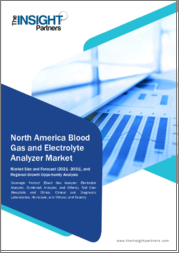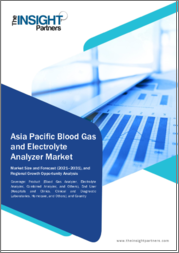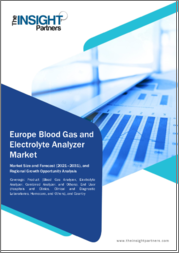
|
시장보고서
상품코드
1624483
세계의 혈액가스 모니터링 시스템 시장 규모 : 제품 유형별, 최종사용자별, 지역별, 범위 및 예측Global Blood Gas Monitoring Systems Market Size By Product Type (Desktop Type, Portable Type), By End-User (Hospitals, Diagnostic Centers), By Geographic Scope And Forecast |
||||||
혈액가스 모니터링 시스템 시장 규모 및 전망
혈액가스 모니터링 시스템 시장 규모는 2024년에 43억 2,000만 달러로 평가되며 2031년에는 68억 3,000만 달러에 달할 것으로 예상되며, 2024-2031년 연평균 5.88% 성장할 것으로 예상됩니다. 시장을 주도하는 주요 요인은 노인 인구 증가와 만성질환의 빈도 증가로 인해 입원이 증가하여 시장을 주도하는 주요 요인입니다. 세계의 혈액가스 모니터링 시스템 시장 보고서는 시장에 대한 종합적인 평가를 제공합니다. 주요 부문, 동향, 시장 성장 촉진요인, 경쟁 구도 시장에서 중요한 역할을 하는 요인 등을 종합적으로 분석합니다.
세계의 혈액가스 모니터링 시스템 시장 정의
혈액가스 모니터는 혈류내 산소, 이산화탄소, 산의 양을 측정하는 기기입니다. 이러한 요소들은 폐질환, 쇼크, 약물 과다복용 등의 질병 진단에 기여합니다. 미국 국립생물공학정보센터(NCBI)에 따르면 병원 중환자실(ICU)과 심장비료실(CCU)에는 혈액가스 모니터링 장비가 필수적입니다. 환자의 동맥혈 가스(ABG) 검사는 환자의 산소화 상태와 산염기 평형을 확인하고 유지하는 데 매우 중요합니다.
이 진단 툴의 유효성은 결과를 적절히 해석할 수 있는지에 달려 있습니다. 산-염기 균형의 이상은 다양한 질병의 합병증을 유발할 수 있으며, 때로는 생명을 위협하는 위험요소가 될 정도로 심각해질 수 있습니다. 중환자실 전문의와 마취과 의사를 포함한 모든 의사는 산-염기 평형에 대해 잘 알고 있어야 하며, HCO3-(pCO2와 관련하여), 표준염기과잉(SBE), 강이온차(SID)는 산-염기 생리학(SID)에서 가장 널리 사용되는 세 가지 접근법입니다.
스튜어트의 SID라는 개념은 완전히 해리된 음이온과 양이온의 차이의 절대값으로 정의되며, 20년 이상 전부터 존재해 왔습니다. 환자의 산소화, 환기, 산염기 상태를 알기 위해서는 동맥혈 가스 모니터링이 바람직한 방법입니다. 비침습적 모니터링이 ABG 모니터링을 거의 대체했음에도 불구하고 비침습적 모니터링 접근법의 타당성을 확인하고 보정하기 위해 ABG 모니터링은 여전히 가치가 있습니다. 펄스옥시미터로 측정한 산소 포화도(SpO2)와 실험실 산소 측정기로 측정한 산소 포화도(SaO2)는 동일하지 않습니다.
맥박 산소포화도 측정기는 헤모글로빈의 기능적 포화도를 측정합니다. 환원 헤모글로빈과 산소화 헤모글로빈의 합에 대한 산소화 헤모글로빈의 양을 백분율로 표시한 것을 기능적 포화도라고 합니다. 실험실 콕시미터는 다양한 파장을 사용하여 서로 다른 형태의 헤모글로빈(메트헤모글로빈과 카르복시헤모글로빈)을 식별하여 순수 분획 포화도, 즉 전체 환원 헤모글로빈의 백분율에 대한 산소화 헤모글로빈의 양을 정량화합니다.
세계의 혈액가스 모니터링 시스템 시장 개요
자동화된 현장 혈액가스 분석기에 대한 수요 증가가 시장 확대의 주요 요인으로 작용하고 있습니다. 이러한 분석기는 빠른 결과를 제공하고, 사용이 간편하고, 휴대가 간편하며, 짧은 시간 내에 결과를 얻을 수 있으며, 중환자실과 응급실에서 산소화 및 환기 관리에 필수적인 툴이 되고 있습니다. 혈액가스 모니터링 시스템 시장의 성장을 가속하는 다른 요인으로는 노인 인구 증가와 만성질환의 유병률 증가, 기술적으로 진보된 바이오 센서 및 데이터 분석 소프트웨어의 채택 증가, 기술 통합형 복합 시스템에 대한 수요 증가, POC 혈액가스 분석기의 소형화 등이 있습니다.
또한 혈액가스 분석기와 전자건강기록 및 검사 정보 시스템과의 통합은 시장 확대의 기회로 작용하고 있습니다. 이러한 통합 기술은 우수한 환자 모니터링을 가능하게 할 뿐만 아니라 워크플로우를 간소화하는 데에도 도움이 됩니다. 하지만, 현장 진료 기기 및 혈액가스 모니터는 가격이 비싸고, 일부 국가에서는 엄격한 규제 요건이 있으며, 시장 확대에 한계가 있습니다. 맥박 산소 농도계는 ICU에서 간헐적 모니터링에 사용하거나 실시간 연속 산소 포화도 측정에 사용할 수 있습니다. 전신마취나 인공호흡 중에는 연속 모니터링이 매우 유용합니다. 호흡기능이 경계에 있는 환자에게 스트레스가 많은 치료(BAL, 기관세척, 원심분리)를 시행하는 경우, 맥박 산소포화도 측정기를 사용하여 포화도 변화를 감지할 수 있습니다.
또한 산소 보충이 필요한지 여부를 평가하는 데 도움이 됩니다. 또한 혈류는 박동성이기 때문에 맥박 산소 농도계 센서의 출력을 전자적으로 처리하여 맥박 파형과 심박수를 제공할 수 있습니다. 결과적으로 펄스옥시미터는 말초 맥박의 속도와 규칙성을 추적하는 데 사용할 수 있습니다. 주요 영양소(포도당, 단백질, 지방) 및 미량영양소(비타민 및 미량 원소)공급 조절, 에너지 요구량과 공급량 사이의 적절성 평가, 마지막으로 혈당 조절은 ICU의 영양 및 대사 치료의 세 가지 주요 목표입니다.
단백질과 에너지 공급이 부족하거나 혈당 관리가 제대로 이루어지지 않으면 ICU의 임상 결과가 나빠진다는 많은 증거가 있으므로 이는 매우 중요한 문제입니다. Alere의 Enterprise Point of Care Blood Analysis 시스템은 스마트카드 기술을 채택한 유일한 무선 베드사이드 검사 옵션입니다. 이 최첨단 기술은 환자의 결과를 PDA(휴대용 정보 단말기)나 전자건강기록으로 직접 전송하므로 의사는 환자의 침대 옆에 머물러 있을 수 있습니다. 휴대용 기기는 사용, 취급 및 유지보수가 간편하므로 수용률이 높습니다. 일부 신흥 국가 시장에서는 이러한 기기의 개발 및 판매에 투자하고 있습니다.
목차
제1장 세계의 혈액가스 모니터링 시스템 시장 : 서론
- 시장 개요
- 조사 범위
- 전제조건
제2장 개요
제3장 VERIFIED MARKET RESEARCH의 조사 방법
- 데이터 마이닝
- 밸리데이션
- 1차 자료
- 데이터 소스 리스트
제4장 세계의 혈액가스 모니터링 시스템 시장 전망
- 개요
- 시장 역학
- 촉진요인
- 억제요인
- 기회
- Porter's Five Forces 모델
- 밸류체인 분석
제5장 세계의 혈액가스 모니터링 시스템 시장 : 제품 유형
- 개요
- 탁상형
- 휴대용 유형
제6장 세계의 혈액가스 모니터링 시스템 시장 : 최종사용자별
- 개요
- 병원
- 심장 카테터 검사실
- 진단 센터
- 외래 수술 센터
- 기타
제7장 세계의 혈액가스 모니터링 시스템 시장 : 지역별
- 개요
- 북미
- 미국
- 캐나다
- 멕시코
- 유럽
- 독일
- 영국
- 프랑스
- 기타 유럽
- 아시아태평양
- 중국
- 일본
- 인도
- 기타 아시아태평양
- 세계의 기타 지역
- 라틴아메리카
- 중동 및 아프리카
제8장 세계의 혈액가스 모니터링 시스템 시장 : 경쟁 구도
- 개요
- 각사 시장 순위
- 주요 발전 전략
제9장 기업 개요
- Abbott Laboratories
- Alere, Inc.
- Instrumentation Laboratory
- Medicacorp
- Optimedical
- Radiometer
- Roche Diagnostics
- SenTec AG
- Siemens Healthcare
- Sphere Medical
제10장 부록
- 관련 조사
Blood Gas Monitoring Systems Market Size And Forecast
Blood Gas Monitoring Systems Market size was valued at USD 4.32 Billion in 2024 and is projected to reach USD 6.83 Billion by 2031, growing at a CAGR of 5.88% from 2024 to 2031 The primary factor driving the market is the growing elderly population and the rising frequency of chronic diseases, which leads to an increase in hospital admissions. The Global Blood Gas Monitoring Systems Market report provides a holistic evaluation of the market. The report offers a comprehensive analysis of key segments, trends, drivers, restraints, competitive landscape, and factors that are playing a substantial role in the market
Global Blood Gas Monitoring Systems Market Definition
Blood gas monitors are instruments that measure the amount of oxygen, carbon dioxide, and acidity in the bloodstream. These factors contribute to the diagnosis of diseases such as lung disorders, shock, and drug overdoses, among others. According to the National Center for Biotechnology Information (NCBI), for intensive care units (ICU) and Cardiac Care Unit (CCU) rooms in the hospital, blood gas monitoring equipment is essential. The examination of a patient's arterial blood gas (ABG) is crucial for identifying and maintaining their oxygenation status and acid-base balance.
The effectiveness of this diagnostic tool is contingent on the ability to interpret the results appropriately. Acid-base imbalances can cause complications in a variety of diseases, and the aberration can sometimes be so severe that it becomes a life-threatening risk factor. Any physician, including an intensivist and an anesthesiologist, must have a good understanding of acid-base balance. The HCO3- (in the context of pCO2), standard base excess (SBE), and strong ion difference (SID) are the three most extensively utilized approaches to acid-base physiology (SID).
Stewart's idea of SID, which is defined as the absolute difference between totally dissociated anions and cations, has been around for more than 20 years. For determining a patient's oxygenation, ventilation, and acid-base status, arterial blood gas monitoring is the preferred method. Despite the fact that non-invasive monitoring has mostly supplanted ABG monitoring, it is still valuable for validating and calibrating non-invasive monitoring approaches. The oxygen saturation measured by a pulse oximeter (SpO2) and the SaO2 measured by a laboratory cooximeter is not the same.
The functional saturation of hemoglobin is measured by the pulse oximeter. The amount of oxygenated hemoglobin in a percentage form of total reduced and oxygenated hemoglobin is known as functional saturation. Cooximeters in laboratories uses various wavelengths to discriminate between different forms of hemoglobin (methemoglobin and carboxyhemoglobin) and so quantify genuine fractional saturation, or the amount of oxygenated hemoglobin in a percentage form of the total reduced.
What's inside a VMR industry report?
Our reports include actionable data and forward-looking analysis that help you craft pitches, create business plans, build presentations and write proposals.
Global Blood Gas Monitoring Systems Market Overview
The increased demand for automated and point-of-care blood gas analyzer devices is mostly responsible for the market's expansion. These analyzers provide quick results, are simple to use, portable, and have quick turnaround times, making them essential tools for managing oxygenation and ventilation in ICUs and emergency rooms. Other factors driving the growth of the Blood Gas Monitoring Systems Market include an older population and an increase in the prevalence of chronic diseases, increased adoption of technologically advanced biosensors and data analysis software, increasing demand for technology-integrated combined systems, and miniaturization of POC blood gas analyzers.
In addition, the integration of blood gas analyzers with electronic medical records and laboratory information systems is presenting a profitable opportunity for market expansion. These integrated technologies not only allow for excellent patient monitoring but also help to streamline the workflow. However, high prices for point-of-care devices and blood gas monitors, as well as severe regulatory requirements in some countries, limit market expansion. The pulse oximeter can be used in the ICU for intermittent monitoring or to offer a continuous real-time oxygen saturation reading. During general anesthesia or ventilation, continuous monitoring is very beneficial. When stressful treatments are performed on patients with borderline respiratory function (BALs, tracheal washes, centesis), the pulse oximeter can be utilized to detect changes in saturation.
It can help us assess whether or not more oxygen supplementation is required. Furthermore, because blood flow is pulsatile, the pulse oximeter sensor's output can be electronically processed to provide a pulse waveform and heart rate. As a result, the pulse oximeter can be used to track the rate and regularity of peripheral pulses. The regulation of macronutrients (glucose, protein, fat) and micronutrients (vitamins and trace elements) delivery, second, the assessment of the adequacy between energy needs and delivery, and finally, glycaemic control are the three primary goals of nutritional and metabolic care in the ICU.
This is a critical issue since a large body of evidence shows that inadequate protein and energy coverage, as well as poor glycemic management, are both linked to a poor clinical outcome in the ICU. The Alere (San Diego) Enterprise Point of Care blood analysis system is the only wireless bedside testing option that employs Smartcard technology. This cutting-edge technology sends patient results straight to a personal digital assistant (PDA) and the electronic medical record, allowing the doctor to remain at the patient's bedside. The portable devices are simple to use, handle, and maintain, which contributes to their higher acceptance rate. Several businesses are making investments in the development and marketing of these items. Though portable devices have an advantage over traditional devices.
Global Blood Gas Monitoring Systems Market Segmentation Analysis
The Global Blood Gas Monitoring Systems Market is Segmented on the basis of Product Type, End-User, And Geography.
Blood Gas Monitoring Systems Market, By Product Type
- Desktop Type
- Portable Type
Based on Product Type, The market is segmented into Desktop Type and Portable Type. There are numerous advantages to using an LED monitor. The biggest advantage is that they offer the highest image quality currently available. In general, a patient monitoring device consists of a sensor for gathering critical patient data (e.g., heart rate) and an interconnect solution (e.g., PCBs, connectors, wire, etc.) for transmitting the data to the capital equipment. The patient monitoring device component of a pulse oximeter, for example, is the piece that clips to your finger and senses and communicates your pulse to the capital equipment.
Blood Gas Monitoring Systems Market, By End-User
- Hospitals
- Cardiac Catheterization Laboratory
- Diagnostic Centers
- Ambulatory Surgical Centers
- Others
Based on End-User, The market is segmented into Hospitals, Cardiac Catheterization Laboratory, Diagnostic Centers, Ambulatory Surgical Centers, Others. A hospital is a medical facility that treats patients with specialized health science and auxiliary healthcare personnel as well as medical equipment. Doctors use catheters instead of surgery to diagnose and treat heart diseases in the cardiac catheterization laboratory. A catheterization lab, rather than an operating room, can safely perform a variety of procedures. Catheters are plastic tubes that resemble spaghetti and are used to introduce special devices to diagnose or treat heart problems.
Blood Gas Monitoring Systems Market, By Geography
- North America
- Europe
- Asia Pacific
- Rest of the world
- On the basis of Geography, The Global Blood Gas Monitoring Systems Market is classified into North America, Europe, Asia Pacific, and the Rest of the world. he Asia Pacific region is expected to witness a significant CAGR during the forecast period. This is primarily due to the primary factor driving the market is the growing elderly population and the rising frequency of chronic diseases, which leads to an increase in hospital admissions.
Key Players
- The "Global Blood Gas Monitoring Systems Market" study report will provide a valuable insight with an emphasis on the global market including some of the major players such as
- Abbott Laboratories, Alere, Inc, Instrumentation Laboratory, Mediacorp, Optimedical, Radiometer, Roche Diagnostics, SenTec AG, Siemens Healthcare, Sphere Medical.
Our market analysis also entails a section solely dedicated to such major players wherein our analysts provide an insight into the financial statements of all the major players, along with its product benchmarking and SWOT analysis. The competitive landscape section also includes key development strategies, market share, and market ranking analysis of the above-mentioned players globally.
Key Developments
- November 2020, In India, Abbott launched the FreeStyle Blood Glucose Monitor for diabetic adults and children (over the age of four) as well as women with gestational diabetes (diabetes during pregnancy).
- November 2021, Abbott released late-breaking data from the global Leadless II IDE study, which looked at Abbott's investigational Aveir leadless pacemaker in people with specific irregular heart rhythms.
- Jan 2019, Perimed AB and Radiometer Medical ApS have partnered to accelerate and increase the marketing of Perimed's PeriFlux 6000 CPO 2 standalone system.
TABLE OF CONTENTS
1 INTRODUCTION OF GLOBAL BLOOD GAS MONITORING SYSTEMS MARKET
- 1.1 Overview of the Market
- 1.2 Scope of Report
- 1.3 Assumptions
2 EXECUTIVE SUMMARY
3 RESEARCH METHODOLOGY OF VERIFIED MARKET RESEARCH
- 3.1 Data Mining
- 3.2 Validation
- 3.3 Primary Interviews
- 3.4 List of Data Sources
4 GLOBAL BLOOD GAS MONITORING SYSTEMS MARKET OUTLOOK
- 4.1 Overview
- 4.2 Market Dynamics
- 4.2.1 Drivers
- 4.2.2 Restraints
- 4.2.3 Opportunities
- 4.3 Porters Five Force Model
- 4.4 Value Chain Analysis
5 GLOBAL BLOOD GAS MONITORING SYSTEMS MARKET, PRODUCT TYPE
- 5.1 Overview
- 5.2 Desktop Type
- 5.3 Portable Type
6 GLOBAL BLOOD GAS MONITORING SYSTEMS MARKET, BY END-USER
- 6.1 Overview
- 6.2 Hospitals
- 6.3 Cardiac Catheterization Laboratory
- 6.4 Diagnostic Centers
- 6.5 Ambulatory Surgical Centers
- 6.6 Others
7 GLOBAL BLOOD GAS MONITORING SYSTEMS MARKET, BY GEOGRAPHY
- 7.1 Overview
- 7.2 North America
- 7.2.1 U.S.
- 7.2.2 Canada
- 7.2.3 Mexico
- 7.3 Europe
- 7.3.1 Germany
- 7.3.2 U.K.
- 7.3.3 France
- 7.3.4 Rest of Europe
- 7.4 Asia Pacific
- 7.4.1 China
- 7.4.2 Japan
- 7.4.3 India
- 7.4.4 Rest of Asia Pacific
- 7.5 Rest of the World
- 7.5.1 Latin America
- 7.5.2 Middle East and Africa
8 GLOBAL BLOOD GAS MONITORING SYSTEMS MARKET COMPETITIVE LANDSCAPE
- 8.1 Overview
- 8.2 Company Market Ranking
- 8.3 Key Development Strategies
9 COMPANY PROFILES
- 9.1 Abbott Laboratories
- 9.1.1 Overview
- 9.1.2 Financial Performance
- 9.1.3 Product Outlook
- 9.1.4 Key Developments
- 9.2 Alere, Inc.
- 9.2.1 Overview
- 9.2.2 Financial Performance
- 9.2.3 Product Outlook
- 9.2.4 Key Developments
- 9.3 Instrumentation Laboratory
- 9.3.1 Overview
- 9.3.2 Financial Performance
- 9.3.3 Product Outlook
- 9.3.4 Key Developments
- 9.4 Medicacorp
- 9.4.1 Overview
- 9.4.2 Financial Performance
- 9.4.3 Product Outlook
- 9.4.4 Key Developments
- 9.5 Optimedical
- 9.5.1 Overview
- 9.5.2 Financial Performance
- 9.5.3 Product Outlook
- 9.5.4 Key Developments
- 9.6 Radiometer
- 9.6.1 Overview
- 9.6.2 Financial Performance
- 9.6.3 Product Outlook
- 9.6.4 Key Developments
- 9.7 Roche Diagnostics
- 9.7.1 Overview
- 9.7.2 Financial Performance
- 9.7.3 Product Outlook
- 9.7.4 Key Developments
- 9.8 SenTec AG
- 9.8.1 Overview
- 9.8.2 Financial Performance
- 9.8.3 Product Outlook
- 9.8.4 Key Developments
- 9.9 Siemens Healthcare
- 9.9.1 Overview
- 9.9.2 Financial Performance
- 9.9.3 Product Outlook
- 9.9.4 Key Developments
- 9.10 Sphere Medical
- 9.10.1 Overview
- 9.10.2 Financial Performance
- 9.10.3 Product Outlook
- 9.10.4 Key Developments
10 Appendix
- 10.1 Related Research



















